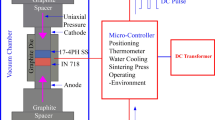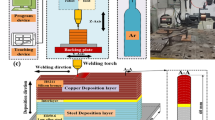Abstract
Spark plasma sintering (SPS) is a powerful technique for consolidating metal powders at a remarkably shorter time with excellent quality. We used this technique for sintering nanocrystalline WC10Co powders and simultaneously bonding with high-strength steel. A series of experiments were conducted in order to find out the optimised set of SPS controlling parameters. The effects of temperatures (1000 to 1150 °C, with a 50 °C interval) in sintering nanocrystalline WC10Co powders and their bonding phenomena with AISI4340 steel were examined at a constant pressure of 80 MPa and a holding time of 5 min. The full density of the carbide powders was achieved at a lower temperature compared with that of conventional techniques. A number of techniques were employed to evaluate the microstructural characteristics of WC and steel bilayered composite and their mechanical properties. For determining the bonding strength of the joint, a novel micro-tensile testing system was adopted. Since such investigation is the first of its kind, to the best knowledge of the authors, where SPS is used to join the tungsten carbide with the steel, this research is expected to provide a valuable future reference for fabricating dissimilar bilayered composite materials.
















Similar content being viewed by others
References
Eriksson M, Radwan M, Shen Z (2013) Spark plasma sintering of WC, cemented carbide and functional graded materials. Int J Refract Met Hard Mater 36:31–37
Cha SI, Hong SH, Kim BK (2003) Spark plasma sintering behavior of nanocrystalline WC–10Co cemented carbide powders. Mater Sci Eng A 351(1–2):31–38
Sivaprahasam D, Chandrasekar S, Sundaresan R (2007) Microstructure and mechanical properties of nanocrystalline WC–12Co consolidated by spark plasma sintering. Int J Refract Met Hard Mater 25(2):144–152
Huang S et al (2008) Tailored sintering of VC-doped WC–Co cemented carbides by pulsed electric current sintering. Int J Refract Met Hard Mater 26(3):256–262
Liu X, Song X, Zhang J, Zhao S (2008) Temperature distribution and neck formation of WC–Co combined particles during spark plasma sintering. Mater Sci Eng A 488(1):1–7
Liu W, Song X, Zhang J, Yin F, Zhang G (2008) A novel route to prepare ultrafine-grained WC–Co cemented carbides. J Alloys Compd 458(1):366–371
Hasan M, Zhao J, Jiang Z (2017) A review of modern advancements in micro drilling techniques. J Manuf Process 29:343–375
Hasan M, Zhao J, Jia F, Wu H, Ahmad F, Huang Z, Wei D, Ma L, Jiang Z (2020) Optimisation of sintering parameters for bonding nanocrystalline cemented tungsten carbide powder and solid high strength steel. Composite Interfaces 8:1–6
Hasan M, Zhao J, Jiang Z (2019) Micromanufacturing of composite materials: a review. International Journal of Extreme Manufacturing 1(1):012004
Zafar S, Sharma AK (2014) Development and characterisations of WC–12Co microwave clad. Mater Charact 96:241–248
Feng K, Chen H, Xiong J, Guo Z (2013) Investigation on diffusion bonding of functionally graded WC–Co/Ni composite and stainless steel. Mater Des 46:622–626
Thomazic A, Pascal C, Chaix JM. Fabrication of (cemented carbides/steel) bilayered materials by powder metallurgy. In Materials Science Forum 2010 (Vol. 631, pp. 239–244). Trans Tech Publications Ltd
Pascal C et al (2009) Design of multimaterial processed by powder metallurgy: processing of a (steel/cemented carbides) bilayer material. Int J Mater Prod Technol 209(3):1254–1261
Lee W-B, Kwon B-D, Jung S-B (2006) Effects of Cr3C2 on the microstructure and mechanical properties of the brazed joints between WC–Co and carbon steel. Int J Refract Met Hard Mater 24(3):215–221
Bao J, Newkirk JW, Bao S (2004) Wear-resistant WC composite hard coatings by brazing. J Mater Eng Perform 13(4):385–388
Zhang XZ, Liu GW, Tao JN, Shao HC, Fu H, Pan TZ, Qiao GJ (2017) Vacuum brazing of WC-8Co cemented carbides to carbon steel using pure Cu and Ag-28Cu as filler metal. J Mater Eng Perform 26(2):488–494
Giménez S, Huang SG, van der Biest O, Vleugels J (2007) Chemical reactivity of PVD-coated WC–Co tools with steel. Appl Surf Sci 253(7):3547–3556
Zhong Z, Hinoki T, Nozawa T, Park YH, Kohyama A (2010) Microstructure and mechanical properties of diffusion bonded joints between tungsten and F82H steel using a titanium interlayer. J Alloys Compd 489(2):545–551
Barrena M, De Salazar JG, Matesanz L (2010) Interfacial microstructure and mechanical strength of WC–Co/90MnCrV8 cold work tool steel diffusion bonded joint with cu/Ni electroplated interlayer. Mater Des 31(7):3389–3394
Haghshenas MS, Parvin N, Amirnasiri A (2018) Effect of bonding temperature on microstructure and mechanical properties of WC–Co/steel diffusion brazed joint. Trans Indian Inst Metals 71(3):649–658
Nascimento MP, Souza RC, Miguel IM, Pigatin WL, Voorwald HJC (2001) Effects of tungsten carbide thermal spray coating by HP/HVOF and hard chromium electroplating on AISI 4340 high strength steel. Surf Coat Technol 138(2–3):113–124
Monticelli C, Frignani A, Zucchi F (2004) Investigation on the corrosion process of carbon steel coated by HVOF WC/Co cermets in neutral solution. Corros Sci 46(5):1225–1237
Singh H, Goyal K, Goyal DK (2017) Experimental investigations on slurry erosion behaviour of HVOF and HVOLF sprayed coatings on hydraulic turbine steel. Trans Indian Inst Metals 70(6):1585–1592
Maiti AK, Mukhopadhyay N, Raman R (2009) Improving the wear behavior of WC-CoCr-based HVOF coating by surface grinding. J Mater Eng Perform 18(8):1060–1066
Toparli M, Sen F, Culha O, Celik E (2007) Thermal stress analysis of HVOF sprayed WC–Co/NiAl multilayer coatings on stainless steel substrate using finite element methods. J Mater Process Technol 190(1–3):26–32
Hasan M, Zhao J, Huang Z, Wu H, Jia F, Jiang Z (2019) Effects of holding time on the sintering of cemented tungsten carbide powder and bonding with high-strength steel wire. J Mater Eng Perform 28(7):4074–4085
Hasan M, Zhao J, Huang Z, Wei D, Jiang Z (2019) Analysis and characterisation of WC-10Co and AISI 4340 steel bimetal composite produced by powder–solid diffusion bonding. Int J Adv Manuf Technol 103(9):3247–3263
Luo L et al (2015) An experimental and numerical study of micro deep drawing of SUS304 circular cups. Manuf Rev 2(27):1–7
Asano H, Bando Y, Nakanishi N, Kachi S (1967) Order-disorder transformation of Fe–Co alloys in fine particles. Trans Jpn Inst Metals 8(3):180–184
Persson K (2016) Materials Data on Fe3Co (SG:123) by Materials Project. LBNL Materials Project; Lawrence Berkeley National Lab. (LBNL), Berkeley, CA (United States): United States
McCammon C, Ringwood A, Jackson I (1983) Thermodynamics of the system Fe—FeO—MgO at high pressure and temperature and a model for formation of the Earth's core. Geophys J Int 72(3):577–595
Hasan M, Zhao J, Huang Z, Chang L, Zhou H, Jiang Z (2018) Analysis of sintering and bonding of ultrafine WC powder and stainless steel by hot compaction diffusion bonding. Fusion Eng Des 133:39–50
Collins GS, Meeves BH (1993) Formation of FeCo by mechanical alloying. Scripta metallurgica et materialia 29(10)
Suetin DV, Shein IR, Ivanovskii AL (2009) Structural, electronic and magnetic properties of η carbides (Fe3W3C, Fe6W6C, Co3W3C and Co6W6C) from first principles calculations. Phys B Condens Matter 404(20):3544–3549
Machado IF, Girardini L, Lonardelli I, Molinari A (2009) The study of ternary carbides formation during SPS consolidation process in the WC–Co–steel system. Int J Refract Met Hard Mater 27(5):883–891
Guilemany JM, de Paco JM, Miguel JR, Nutting J (1999) Characterization of the W2C phase formed during the high velocity oxygen fuel spraying of a WC + 12 pct Co powder. Metall Mater Trans A 30(8):1913–1921
Telmenbayar L, Temuujin J (2016) Preparation of tungsten carbide from mixtures of natural wolframite and carbon-containing solid fuels with assistance of mechanical activation. J Ceram Process Res 17(5):489–493
Fang ZZ, Wang X, Ryu T, Hwang KS, Sohn HY (2009) Synthesis, sintering, and mechanical properties of nanocrystalline cemented tungsten carbide–a review. Int J Refract Met Hard Mater 27(2):288–299
Goren-Muginstein G, Berger S, Rosen A (1998) Sintering study of nanocrystalline tungsten carbide powders. Nanostruct Mater 10(5):795–804
Acknowledgements
We acknowledge the use of facilities within the UOW Electron Microscopy Centre.
Funding
The authors would like to thank the Australian Research Council (ARC) for its financial support for the study.
Author information
Authors and Affiliations
Corresponding author
Additional information
Publisher’s note
Springer Nature remains neutral with regard to jurisdictional claims in published maps and institutional affiliations.
Rights and permissions
About this article
Cite this article
Hasan, M., Huang, Z., Zhao, J. et al. Microstructural evaluation of WC and steel dissimilar bilayered composite obtained by spark plasma sintering. Int J Adv Manuf Technol 111, 2405–2418 (2020). https://doi.org/10.1007/s00170-020-06210-z
Received:
Accepted:
Published:
Issue Date:
DOI: https://doi.org/10.1007/s00170-020-06210-z




